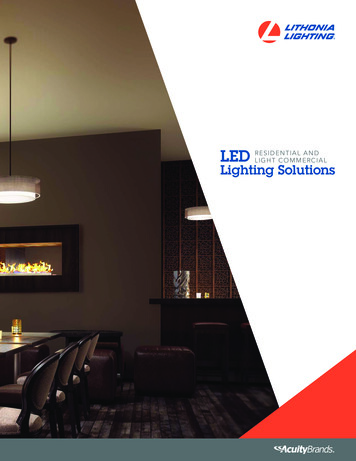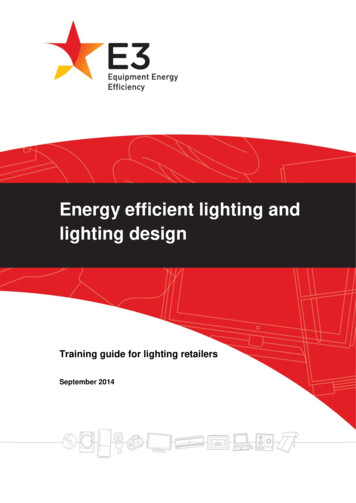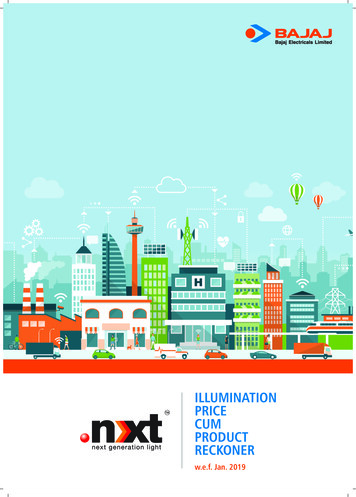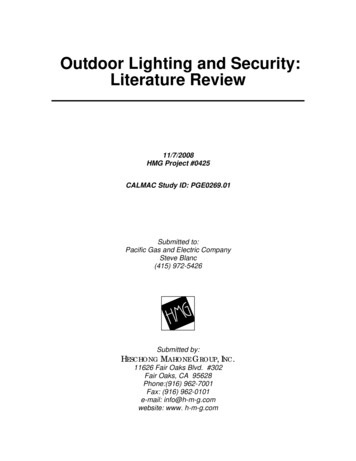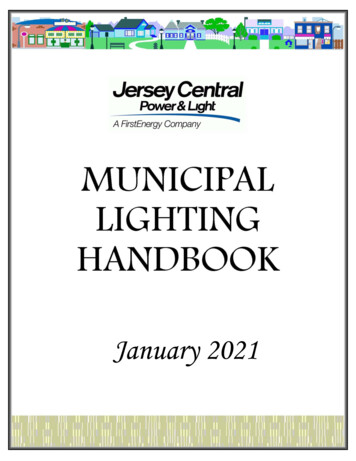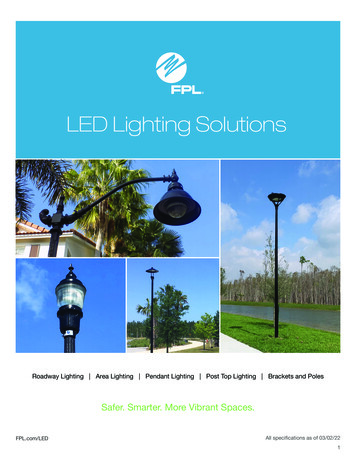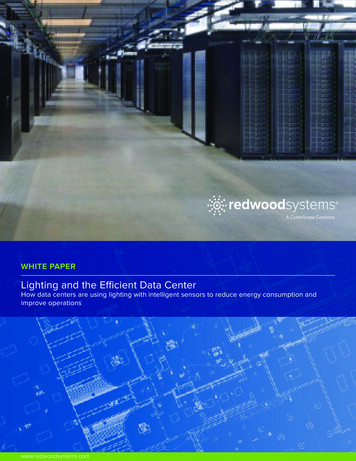
Transcription
WHITE PAPERLighting and the Efficient Data CenterHow data centers are using lighting with intelligent sensors to reduce energy consumption andimprove operationswww.redwoodsystems.com
.TABLE OF CONTENTS01EXECUTIVE SUMMARY: LIGHTING AND THE EFFICIENT DATA CENTER01WHAT IS THE MOST EFFICIENT LIGHTING APPROACH FOR A DATA CENTER?03LIGHTS-ON DATA CENTERS06THE MOST EFFICIENT BUILDING-PERFORMANCE LIGHTING PLATFORM ON THE PLANETLIGHTING AND THE EFFICIENT DATA CENTERi
.This paper describes the role that lighting plays within data centers. While a common approach to lighting in datacenters is to leave the lights off, there are practical reasons why many data centers cannot adopt that approach.Though lighting is not a major component of the energy load in a data center, it is an infrastructure area that isrelatively easy to address. Redwood Systems’ Building-Performance Lighting Platform is one of the more efficientmethods of lighting a data center.EXECUTIVE SUMMARY: LIGHTING AND THE EFFICIENT DATA CENTERAs data center operators and architects consider different ways to make their data centers more efficient, often thelast area they consider is lighting. While lighting only comprises 3%-5% of a data center’s energy load, it’s one ofthe easiest areas to address — one that will help take a data center with good Power Utilization Effectiveness (PUE)to one with great PUE.Lighting has not gone unnoticed by industry experts. The Telecommunication Infrastructure Standard for DataCenters ANSI/TIA-942-A recommends that data center operators implement LED lighting within their facilities.However, just changing the lighting doesn’t make the data center as efficient as it can be. In this paper, we will lookat different approaches to data center lighting and define the approach that requires the least amount of light andresults in the best efficiency.WHAT IS THE MOST EFFICIENT LIGHTING APPROACH FOR A DATA CENTER?The most efficient way to provide light in a data center is to use it precisely when and where it is needed. This iseffectively a lights-out data center approach. While many data center operators believe they operate a lights-outtype of facility, in practice, this is often not the case. In facilities with this type of policy, lights are turned on manuallyacross a large swath of space when a technician enters the racks to get to a particular small section of the site,such as an aisle. Lights often remain on long after the technician has departed because they were never turned off,sometimes simply because the technician doesn’t know whether anyone else is present or not. This scenariocreates a perfect opportunity to introduce innovative lighting control techniques.For example, a recent webinar conducted by ComputerWorld 1 featuring KC Mares from MegaWatt Consultingdescribed new techniques used by data centers with exceptional PUE. Notably, KC discussed an approach calledfollow-me lighting used at Facebook’s Oregon and North Carolina data centers. Follow-me lighting does exactlywhat a spotlight does, it puts lighting only where the technicians are. As people move through their facility, only thelights above the technician are illuminated. In order to do this, they have motion-detecting sensors at each lightfixture. These sensors tie into a central application that determines which lights come on and the light’s intensity.The follow-me approach solves the problem of putting light only where it’s needed, but, as many have learned, thetype of fixtures used have a big impact. The inexpensive and familiar solution is to use fluorescent fixtures.LIGHTING AND THE EFFICIENT DATA CENTER01
.Figure 1: Follow-me Lighting in the Data CenterFluorescent lights are an improvement over incandescent lighting, they’ve been around a long time, and they’rerelatively inexpensive. In the last 10 years, their efficiency has improved by producing smaller tubes with dimmableballasts. However, they still have their drawbacks. First, the life of a fluorescent lamp diminishes with the number ofstarts it endures 2. In a follow-me lighting environment, the lamps will undergo at least twice as many starts versus aconventional approach of turning the lights on and off when entering and leaving the data center. The diminishedlife exacerbates the second, bigger problem with fluorescent lamps—they need to be maintained. The average lifeof a fluorescent lamp is about 6000-7000 hours and, as mentioned earlier, decreases with the number of starts.With hundreds of lamps in a data center, maintenance becomes a constant and costly process. Once a fluorescentlamp is replaced, it can’t simply be thrown away. It must be disposed of as hazardous waste to prevent mercuryfrom getting into the environment. If a tube breaks, there is the challenge of getting those materials out of the datacenter.Most fluorescents are not deployed with dimming capabilities. They are either on, full power, or they are off. In fact,dimming, like turning them on and off, also diminishes the life of the fluorescent lamp. There may be situationswhere low lighting is completely adequate, but fluorescents are limited in their ability to dim to a low output. Finally,they’re not the most energy efficient lighting platform. LED lighting has surpassed fluorescent lighting in energyefficiency and lighting quality.LIGHTING AND THE EFFICIENT DATA CENTER02
.The ANSI TIA-942-A standard 3 recommends the use of LED fixtures in data centers for three reasons: theyconsume less electricity, they generate less heat and they are nearly 100% dimmable. Many data center managerswill balk at LED fixtures due to their perceived higher cost. However, LED fixture prices are continuously droppingand, because LEDs have a longer life, typically 50,000 hours and up, and don’t use bulbs or ballasts, maintenancecosts are considerably less than fluorescents. Another benefit of reducing the amount of energy used for lightingshows up in HVAC costs. For every three watts reduced in lighting, there is a corresponding one watt reduction inHVAC load. The combination of better efficiency, lower maintenance costs, and declining prices, make LED lightsan easy choice for data centers.Not all LED fixtures are created equal, however. While the advantage of using LEDs is obvious, there is still onemore wrinkle. LEDs are direct current (DC) devices. To operate, they need a transformer or driver that converts ACline voltage to DC power. This process of conversion occurs at the driver, which is usually a part of the fixture. Whenenergy is converted, energy is lost and it is transformed into heat. This heat is dissipated from the driver into thesurrounding air. For a data center, this means more heat in the facility and greater load on the HVAC. However,there are fixtures available that do not have drivers. These fixtures are connected to a central engine that providespower conversion and control, like the engines provided by Redwood Systems used in Facebook’s data center. Byperforming the conversion at the engine, low-voltage Cat 5e/6/6a cabling can be used to run power to the fixtures,thereby avoiding the expense of deploying AC line voltage cabling. Another advantage of performing powerconversion at the Redwood Engine is it takes heat out of the aisles.Let’s review how we got to the most efficient lighting. We only put lighting where it was needed by using follow-melighting. We used the most efficient lighting available – LED lighting. We used driverless LEDs and put the powerconversion and control in a central engine and made the LEDs even more efficient. As a side benefit, we reducedour maintenance costs, disposal costs, and our HVAC load.LIGHTS-ON DATA CENTERSWe’ve addressed the lights-off data center example, but there are still many data centers that operate with theirlights-on. Though they may not have personnel in the data center at all times, their facilities are accessible at alltimes. Even when people are not present, as a security precaution, they provide lighting to support videosurveillance. Commonly, data center operators deploy IP video cameras with corresponding data storage. Withoutgoing into the detailed differences between IP video solutions, there are some common points. With more light,the video cameras perform better. They can provide better resolution, they’re less expensive and they use lessstorage. To achieve the best video resolution possible, data center operators leave the lights on. This is wheredimming can have big impact. While cameras work better with better light, the amount of light required is muchless than full power. A very efficient and successful approach is to operate lighting at 20% and increase theintensity, only when people are present, using follow-me lighting. This optimizes the effectiveness of the videocameras and provides ample lighting when the technicians require it. As mentioned before, this will only work withLED lighting because of its dimming advantages.LIGHTING AND THE EFFICIENT DATA CENTER03
.Let’s compare data centers that are lights-on with those that use follow-me lighting and with those that use a hybridapproach where they dim the lights combined with follow-me lighting. This example only focuses on energyconsumption and doesn’t factor labor, maintenance and disposal costs. It also doesn’t factor in ancillary benefits,like heat reduction by using centrally controlled LEDs.Let’s start with the fixtures. A typical form factor is the 4-foot bar pendant that is suspended in the aisles of the datacenter. A typical two-lamp fluorescent bar pendant uses 90 watts and an equivalent LED fixture uses 36 watts.Table 1: Average Wattage per FixtureWe’ll use the case of a 100,000 sq. ft. data center and compare five scenarios: a 24x7 operation using fluorescents,a 24x7 operation using LEDs, 24x7 with dimming and follow-me lighting, a lights-off data center, and one that onlyuses follow-me lighting.Table 2: Energy Use Comparison by Lighting Type and MethodLIGHTING AND THE EFFICIENT DATA CENTER04
.The reduction in energy attributed to switching to LEDs is pretty compelling. LEDs use about 40% of the energy ofa conventional fluorescent fixture. When you use LEDs with dimming and follow-me lighting, the energy reductionis astonishing. The following chart illustrates it best.Figure 2: Annual Cost Comparison by Lighting MethodologyThe chart illustrates that the lighting type and hours of operation are the two biggest contributors to lighting energyconsumption. If you want to reduce the amount of energy used for lighting, use an efficient fixture and reduce theamount of time the lights are on. If you want to absolutely minimize the amount of energy used for lighting, the bestapproach is to use LED fixtures with follow-me lighting.Many operators have an anecdotal assumption of how long the lights are on in their data centers. However, sincethey’re not there to monitor the lights all the time, they can be far off. Fortunately, there is an inexpensive tool todetermine exactly how much lighting energy is used in their data center. This device is a HOBO U9 Light On/OffData Logger. By placing the HOBO in the data center an operator can track precisely how much lighting is usedover a period of time. This empirical information can be used to guide data center operators to select the approachthat works best for them.The bottom line is – a data center that uses follow-me lighting will be more efficient than a lights-off data center.When coupled with an energy efficient lighting source, the benefits are even greater.LIGHTING AND THE EFFICIENT DATA CENTER05
.REDWOOD SYSTEMS: THE MOST EFFICIENT BUILDING-PERFORMANCE LIGHTING PLATFORM ONTHE PLANETRedwood Systems offers a unique solution that combines low-cost LED lighting with an integrated intelligent sensornetwork to optimize efficiency throughout the data center. Redwood offers a number of key advantages.By combining multiple sensors for motion, lighting, energy metering, and temperature in a single device,Redwood’s super-sensor can be deployed at each and every light, creating a dense grid with coverage for every100 square feet of building space. This density provides an infrastructure capable of truly comprehensive sensing,reporting, and environmental monitoring—like having a high-definition view of the data center versus a roughsketch.With the comprehensive sensor network, several applications can be deployed. Follow-me lighting, introducedearlier, is simply an embedded script that takes motion detection and feeds it back to an action, turning on a light.Simply put, follow-me lighting can’t be implemented without a comprehensive sensor network. Another applicationis security. Now that sensors can detect where people are, alerts can be generated when people enter areaswhere they are not supposed to be.The Redwood Platform monitors and controls the lighting behavior based on input from the sensors andpreferences set by the administrator. This smart platform has the extensibility to communicate over an IP-networkthrough an application programming interface (API) with applications built on top of it by partners and customers, aswell as the ability to monitor other systems through BACnet building automation protocol, providing efficient,centralized monitoring, and management.Finally, if the system is powering and controlling the lights, it should also be able to measure the power itconsumes. That’s an important requirement for data centers and something that is inherently built into Redwood’ssolution. Not only can data center operators claim to reduce energy, they can track it without the need for anadditional power-monitoring device.We’ve established that the most effective way to light a data center is to use LED lighting with centralized powerand control and follow-me lighting. Because there are sensors at every fixture, Redwood Systems takes that sensorinformation, delivers on the lighting applications, and extends the information to other systems to deliver a platformthat goes beyond simply being the most efficient lighting platform on the planet.1 - Improve Data Center Efficiency through Building-Performance Lighting and an Intelligent Infrastructure - 2 - The Fluorescent Lighting System - fluorescent/lamps.html3 - TIA Approves 942-A Data Center Standard, Cabling Installation and Maintenance - May 1, 2012LIGHTING AND THE EFFICIENT DATA CENTER06
www.redwoodsystems.comCORPORATE HEADQUARTERS3839 Spinnaker Court, Fremont, CA, 94538, USAToll Free: 1 800 840 0709Telephone: 1 510 270 5360Email: sales@redwoodsys.comEUROPEAN HEADQUARTERS20 Hanover Square, London, W1S 1JY, UKTelephone: 44 (0)2035 853647Email: salesemea@redwoodsys.com 2013. Redwood Systems, Inc. All rights reserved.All other trademarks are the property of their respective owners.
Centers ANSI/TIA-942-A recommends that data center operators implement LED lighting within their facilities. However, just changing the lighting doesn’t make the data center as efficient as it can be. In this paper, we will look at different approaches to data center lighting and define


